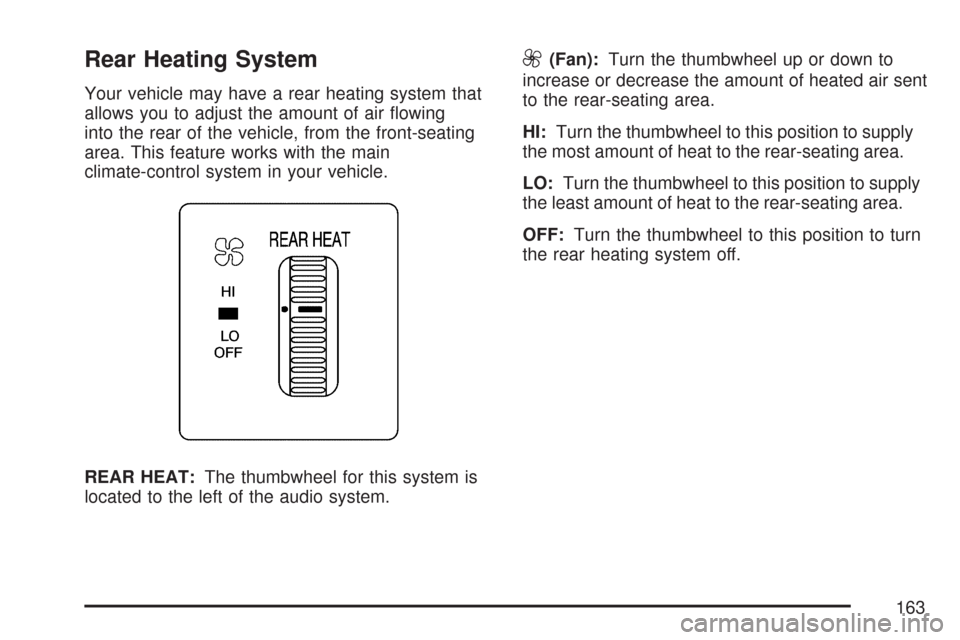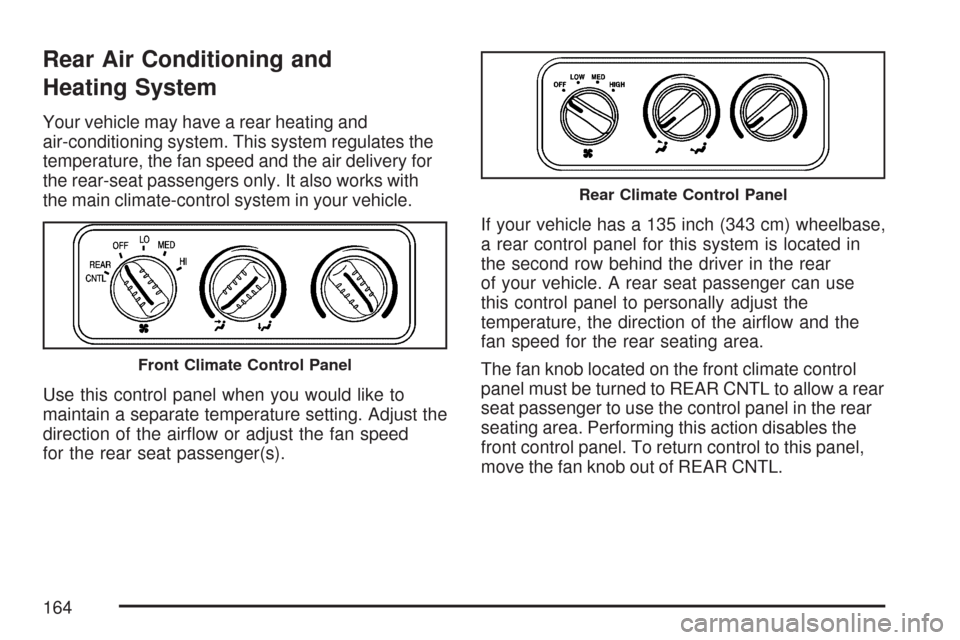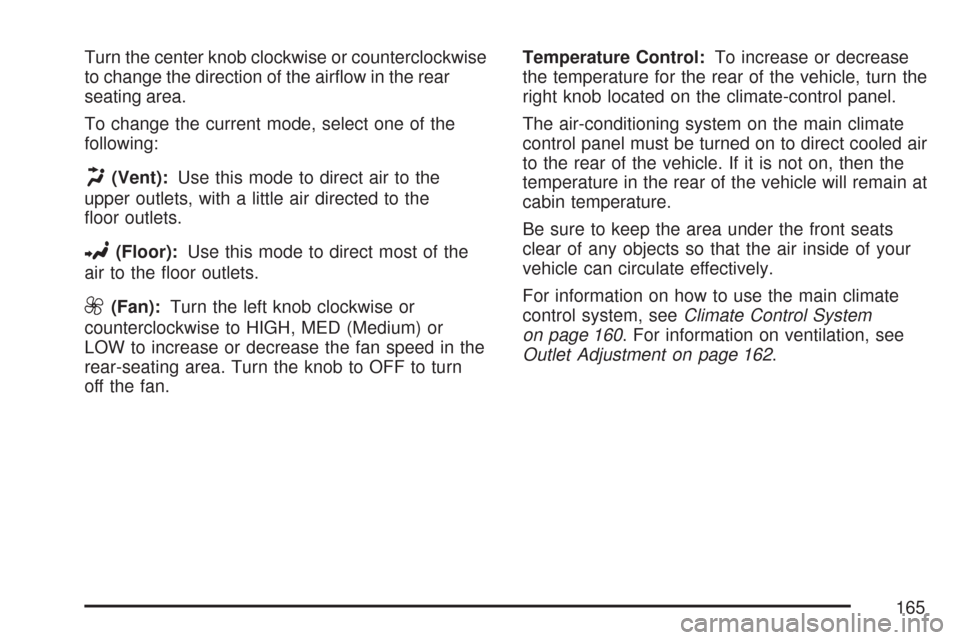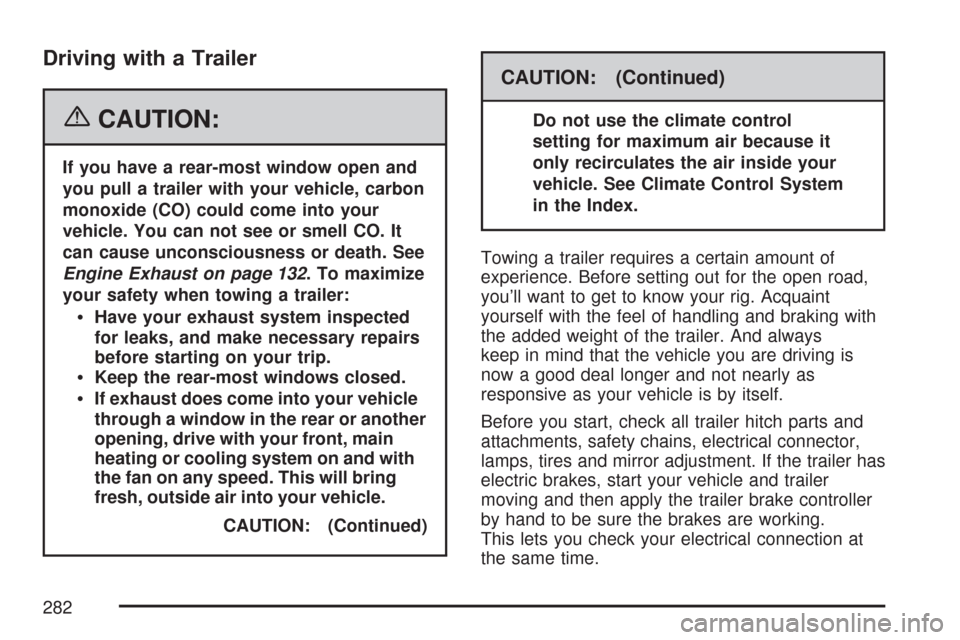2007 CHEVROLET EXPRESS PASSANGER climate control
[x] Cancel search: climate controlPage 163 of 458

Rear Heating System
Your vehicle may have a rear heating system that
allows you to adjust the amount of air flowing
into the rear of the vehicle, from the front-seating
area. This feature works with the main
climate-control system in your vehicle.
REAR HEAT:The thumbwheel for this system is
located to the left of the audio system.
9(Fan):Turn the thumbwheel up or down to
increase or decrease the amount of heated air sent
to the rear-seating area.
HI:Turn the thumbwheel to this position to supply
the most amount of heat to the rear-seating area.
LO:Turn the thumbwheel to this position to supply
the least amount of heat to the rear-seating area.
OFF:Turn the thumbwheel to this position to turn
the rear heating system off.
163
Page 164 of 458

Rear Air Conditioning and
Heating System
Your vehicle may have a rear heating and
air-conditioning system. This system regulates the
temperature, the fan speed and the air delivery for
the rear-seat passengers only. It also works with
the main climate-control system in your vehicle.
Use this control panel when you would like to
maintain a separate temperature setting. Adjust the
direction of the airflow or adjust the fan speed
for the rear seat passenger(s).If your vehicle has a 135 inch (343 cm) wheelbase,
a rear control panel for this system is located in
the second row behind the driver in the rear
of your vehicle. A rear seat passenger can use
this control panel to personally adjust the
temperature, the direction of the airflow and the
fan speed for the rear seating area.
The fan knob located on the front climate control
panel must be turned to REAR CNTL to allow a rear
seat passenger to use the control panel in the rear
seating area. Performing this action disables the
front control panel. To return control to this panel,
move the fan knob out of REAR CNTL.
Front Climate Control Panel
Rear Climate Control Panel
164
Page 165 of 458

Turn the center knob clockwise or counterclockwise
to change the direction of the airflow in the rear
seating area.
To change the current mode, select one of the
following:
H(Vent):Use this mode to direct air to the
upper outlets, with a little air directed to the
floor outlets.
2(Floor):Use this mode to direct most of the
air to the floor outlets.
9(Fan):Turn the left knob clockwise or
counterclockwise to HIGH, MED (Medium) or
LOW to increase or decrease the fan speed in the
rear-seating area. Turn the knob to OFF to turn
off the fan.Temperature Control:To increase or decrease
the temperature for the rear of the vehicle, turn the
right knob located on the climate-control panel.
The air-conditioning system on the main climate
control panel must be turned on to direct cooled air
to the rear of the vehicle. If it is not on, then the
temperature in the rear of the vehicle will remain at
cabin temperature.
Be sure to keep the area under the front seats
clear of any objects so that the air inside of your
vehicle can circulate effectively.
For information on how to use the main climate
control system, seeClimate Control System
on page 160. For information on ventilation, see
Outlet Adjustment on page 162.
165
Page 282 of 458

Driving with a Trailer
{CAUTION:
If you have a rear-most window open and
you pull a trailer with your vehicle, carbon
monoxide (CO) could come into your
vehicle. You can not see or smell CO. It
can cause unconsciousness or death. See
Engine Exhaust on page 132. To maximize
your safety when towing a trailer:
Have your exhaust system inspected
for leaks, and make necessary repairs
before starting on your trip.
Keep the rear-most windows closed.
If exhaust does come into your vehicle
through a window in the rear or another
opening, drive with your front, main
heating or cooling system on and with
the fan on any speed. This will bring
fresh, outside air into your vehicle.
CAUTION: (Continued)
CAUTION: (Continued)
Do not use the climate control
setting for maximum air because it
only recirculates the air inside your
vehicle. See Climate Control System
in the Index.
Towing a trailer requires a certain amount of
experience. Before setting out for the open road,
you’ll want to get to know your rig. Acquaint
yourself with the feel of handling and braking with
the added weight of the trailer. And always
keep in mind that the vehicle you are driving is
now a good deal longer and not nearly as
responsive as your vehicle is by itself.
Before you start, check all trailer hitch parts and
attachments, safety chains, electrical connector,
lamps, tires and mirror adjustment. If the trailer has
electric brakes, start your vehicle and trailer
moving and then apply the trailer brake controller
by hand to be sure the brakes are working.
This lets you check your electrical connection at
the same time.
282
Page 361 of 458

Uniform Tire Quality Grading
Quality grades can be found where applicable on
the tire sidewall between tread shoulder and
maximum section width. For example:
Treadwear 200 Traction AA Temperature A
The following information relates to the system
developed by the United States National Highway
Traffic Safety Administration (NHTSA), which
grades tires by treadwear, traction, and
temperature performance. This applies only to
vehicles sold in the United States. The grades are
molded on the sidewalls of most passenger car
tires. The Uniform Tire Quality Grading (UTQG)
system does not apply to deep tread, winter-type
snow tires, space-saver, or temporary use
spare tires, tires with nominal rim diameters of
10 to 12 inches (25 to 30 cm), or to some
limited-production tires.
While the tires available on General Motors
passenger cars and light trucks may vary with
respect to these grades, they must also conform
to federal safety requirements and additional
General Motors Tire Performance Criteria (TPC)
standards.
Treadwear
The treadwear grade is a comparative rating
based on the wear rate of the tire when tested
under controlled conditions on a specified
government test course. For example, a tire
graded 150 would wear one and a half (1.5) times
as well on the government course as a tire
graded 100. The relative performance of tires
depends upon the actual conditions of their use,
however, and may depart significantly from
the norm due to variations in driving habits, service
practices, and differences in road characteristics
and climate.
Traction – AA, A, B, C
The traction grades, from highest to lowest, are AA,
A, B, and C. Those grades represent the tire’s
ability to stop on wet pavement as measured under
controlled conditions on specified government test
surfaces of asphalt and concrete. A tire marked C
may have poor traction performance.
Warning:The traction grade assigned to this tire
is based on straight-ahead braking traction
tests, and does not include acceleration, cornering,
hydroplaning, or peak traction characteristics.
361
Page 394 of 458

Floor Console Fuse Block
The floor console fuse block is located under the
driver’s seat.
Fuse Usage
1 Spare
2 Outside Rear View Mirror
3 Courtesy Lamp/SEO
Fuse Usage
4 Left Rear Stop/Turn Signal
5 Cargo Locks
6 Right Rear Stop/Turn Signal
7 Driver Locks
8Stop/Center High Mounted
Stop Lamp
9 Climate Control 1
10 Climate Control
11 Brakes
12 Heated Mirror/Defogger
13 Right Rear Blower
14 Driver Turn Mirror
15 Door Locks
16 Upfitter Park
17 Not Available
18 Left Rear Park Lamp
19 Pass Turn Mirror
20 Right Rear Park Lamp
394
Page 397 of 458

Fuse Usage
38Powertrain Control Module Ignition 1
(Gas), Engine Control Module,
Transmission Control Module,
Glow Plug Control Module Ignition 1
(Diesel)
39Oxygen Sensor B (Gas),
Spare (Diesel)
40Oxygen Sensor A (Gas),
Spare (Diesel)
41 Windshield Wipers
42 Right Headlamp - Low Beam
43 Left Headlamp - Low Beam
44 Left Headlamp - High Beam
45 Right Headlamp - High Beam
46Truck Body Controller- Accessory
(Gas), Truck Body Controller,
Transmission Control Module
Accessory (Diesel)
47 Front Windshield Wiper
48Anti-lock Brakes, Vehicle Stability
Enhancement System
49 Ignition A
50 TrailerFuse Usage
51 Climate Control Blower
52 Ignition B
63Spare (Gas), Engine Control
Module Actuator (Diesel)
64 Spare
Relays Usage
53 Windshield Wiper
54 Air Conditioning
55Spare (Gas), Rear Fog
Lamps (Diesel)
56 Headlamp - High Beam
57 Fuel Pump
58 Headlamp - Low Beam
59 Horn
SPARE (G),
ECM (D)Spare (Gas), Engine
Control Module (Diesel)
STRTR Starter
Circuit Breaker Usage
PWR SEAT Power Seat
397
Page 447 of 458

Capacities and Specifications...................... 398
Carbon Monoxide......................132, 256, 269
Care of
Safety Belts............................................. 385
Your Cassette Tape Player....................... 224
Your CD Player........................................ 226
Your CDs ................................................. 225
Cargo Door Relocking................................. 109
Center High-Mounted Stoplamp (CHMSL).... 342
Center Passenger Position, Safety
Belts................................................... 33, 34
Chains, Tire................................................. 364
Charging System Light................................ 174
Check
Engine Light............................................ 178
Gages Warning Light............................... 185
Checking Things Under the Hood................ 300
Chemical Paint Spotting.............................. 390
Child Restraints
Child Restraint Systems............................. 47
Infants and Young Children........................ 44
Lower Anchors and Tethers for Children..... 54
Older Children........................................... 41
Securing a Child Restraint in a Center
Seat Position.......................................... 66Child Restraints (cont.)
Securing a Child Restraint in a Rear
Outside Seat Position or the Second
Row Center Seat Position...................... 63
Securing a Child Restraint in the Right
Front Seat Position.......................... 68, 72
Where to Put the Restraint........................ 52
Chime Level Adjustment.............................. 226
Cigarette Lighter.......................................... 159
Cleaning
Aluminum Wheels.................................... 388
Exterior Lamps/Lenses............................. 386
Fabric/Carpet........................................... 384
Finish Care.............................................. 386
Inside of Your Vehicle.............................. 382
Instrument Panel, Vinyl, and Other Plastic
Surfaces............................................... 385
Tires........................................................ 389
Underbody Maintenance........................... 390
Washing Your Vehicle.............................. 386
Weatherstrips........................................... 385
Windshield and Wiper Blades................... 387
Climate Control System............................... 160
Outlet Adjustment..................................... 162
Rear Air Conditioning and Heating
System................................................. 164
Rear Heating System............................... 163
447